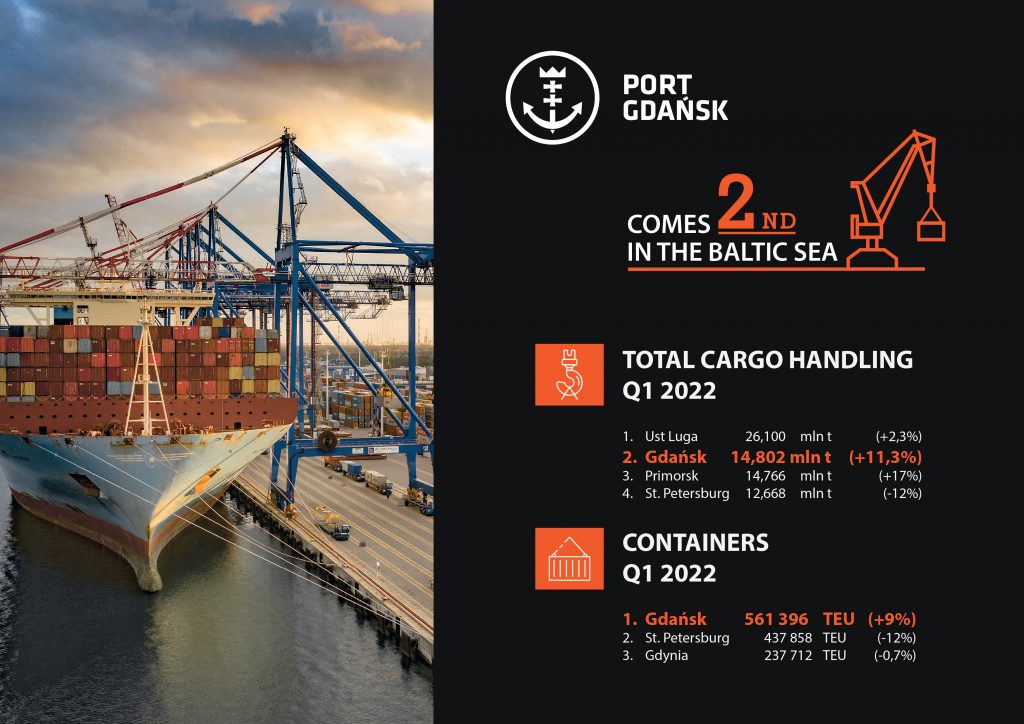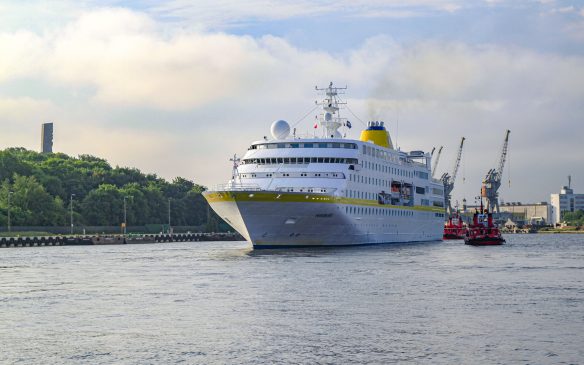The Gdańsk Port moved up to second place in the ranking of Baltic Sea ports

The largest Polish port surpassed two Russian ports (in Primorsk and Saint Petersburg) in Q1 2022 and moved up to the second spot in the ranking of Baltic Sea ports in terms of cargo handled:
| 1st place Ust-Luga port | 26.1 million tonnes +2.3% |
| 2nd place Gdańsk port | 14.802 million tonnes +11.3% |
| 3rd place Primorsk port | 14.766 million tonnes +17% |
| 4th place Saint Petersburg | 12.668 million tonnes -12% |
In addition, after the first quarter of 2022, it maintains the 1st place in terms of container handling in the Baltic Sea:
| 1st place Gdańsk port | 561,396 TEU +9% |
| 2nd place Saint Petersburg | 437,858 TEU -12% |
| 3rd place Gdynia port | 237,712 TEU -0.7% |
Since the beginning of 2022, the port in Gdańsk has recorded very good results in most cargo groups, achieving positive dynamics (quarter to quarter) of +11.3%. In the first quarter of this year, the port in Gdańsk handled 14.8 million tonnes of goods – which marks an increase of 11.3% as compared to the same period of the previous year. General cargo remains the largest cargo group with about 6 million tonnes (and an increase of 2%). Liquid fuels are in second place, having recorded an increase of 25.7% and a result of 5.7 million tonnes. There’s a positive trend in the case of coal, too, with 1.6 million tonnes handled. There was also an increase in the sectors of containers (+9%), passengers (+12.3%) and Ro-Ro cargo (+19.6%). The record belongs to timber – the quantity handled increased by 3,535% as compared to the previous year. Decreases were noted in the case of grain and other mass cargo.
‘Our main task, which we consistently pursue, involves modernisation of the port infrastructure. We have finalised key projects related to access infrastructure both from the water and land. We are doing this for our current and future trading partners. With these actions, the Port in Gdańsk is today the leader in the Baltic Sea. This is evidenced by constantly increasing quantities of cargo handled. This year, we estimate a result at the level of 55 million tonnes. If we achieve the goals we have set ourselves for this year, we will have an opportunity to achieve an even higher result. However, we must bear in mind that planning has become much more difficult in today’s geopolitical situation and many scenarios need to be taken into account’, said Łukasz Greinke, President of the Port of Gdańsk Authority.
Currently, the Port of Gdańsk handles 21 regular sea connections. Apart from Europe, the regular destinations of goods are the USA, Central and South America, and Asia. Considering the available ocean connections (alliances: 2M and Ocean Alliance), the Port of Gdańsk is the only Baltic port that supports direct container connections with China. The world’s largest transoceanic vessels, requiring deep-water berths, arrive at the port. Due to its geographical advantages, the port is already among the key points on the logistic map of the world, one of the main links of the Trans-European Transport Corridor No. 6, which connects the Scandinavian countries with the countries located on the Adriatic Sea. This makes the Port of Gdańsk a gateway for goods imported and exported by Central and Eastern European companies.
Contact for the media:
Anna Drozd – spokesperson for the Port of Gdańsk
e-mail: anna.drozd@portgdansk.pl
tel: (+48) 727 064 605



